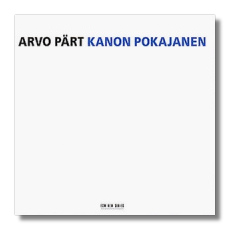
The Internet's Premier Classical Music Source
Related Links
- Pärt Reviews
- Latest Reviews
- More Reviews
-
By Composer
-
Collections
DVD & Blu-ray
Books
Concert Reviews
Articles/Interviews
Software
Audio
Search Amazon
Recommended Links
Site News
 CD Review
CD Review
Arvo Pärt

Kanon pokajanen
Estonian Philharmonic Chamber Choir/Tõnu Kaljuste
ECM New Series 1654/55 (78118-21654-2) DDD 2CDs: 42:44, 40:30
Despite the fact that it was written to celebrate the 750th anniversary of the Cologne Cathedral, Kanon pokajanen sounds like a private work, very close to the heart of Estonian-born composer Arvo Pärt. The text, sung in Church Slavonic, is a plea for repentance that is quite a bit older than even the Cologne Cathedral; scholars date it to somewhere around 700 A.D. Pärt believes that the use of Church Slavonic had a major impact on the compositional process, although the differences well might have been subconscious. Comparing Kanon pokajanen with the English-language Litany, he writes, "I used identical, strictly defined rules of composition and yet the outcome is very different in each case."
It is not surprising, then, that unwary listeners who happen across Kanon pokajanen on the speakers of their local record store might mistake it for a recording of traditional music associated with the Russian Orthodox church. The components are there: a cappella choir, the rock-solid bass foundation, sonorous parallel harmonies, an aura of religious mystery and a barely concealed ecstasy that erupts now and then, only to settle back into a dimly-lit but rapt obscurity. The dynamics of this work are quiet. But, as is generally the case with Pärt, less is more, and an attentive session with Kanon pokajanen could set off clamorous spiritual voices in the listener's head.
What makes the music seem modern, if only barely, is Pärt's harmonic shifting – his compositional "vehicle" is run by virtue of a most subtle transmission – and his fine sensitivity to silence as well as sound. The latter characteristic was most pronounced on Tabula rasa, the very first ECM New Series release of Pärt's music (a contemporary music classic by any reckoning), although it never has been absent since Pärt's writing style changed in the 1970s. However, subtle harmonic transformations and exquisite empty spaces are what make the music of 15th-century composers such as Josquin Des Préz and Johannes Ockeghem seem so modern. Nothing Pärt has written since Tabula rasa has been so earth-shattering, but there is no denying the continued sincerity and inspired excellence of his work in the last 15 years. As ECM's press kit shows, even dour rock musicians the likes of Michael Stipe (REM) and Nick Cave (Nick Cave and the Bad Seeds) acknowledge Pärt's impact on the world of music, as a whole.
This is the third Pärt recording in a row to feature the Estonian Philharmonic Chamber Choir. Its 28 voices are well suited to the composer's technical and interpretive requests. The recording itself was made in an Estonian church, and so the sonics are anything but sterile. The booklet is not overly helpful; texts and translations are supplied, but only sequentially, and the two essays (one of them by the composer) never get down to specifics about the actual music.
Apparently this two-CD set is being offered at a somewhat reduced price, in order to compensate listeners for the short playing times on each disc. But at any price, Kanon pokajanen would be sufficient unto itself.
Copyright © 1999, Raymond Tuttle




















